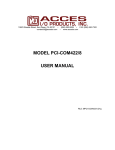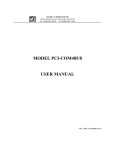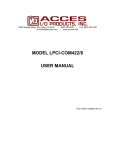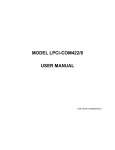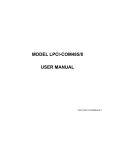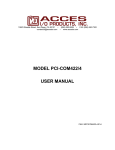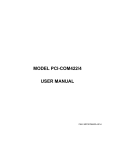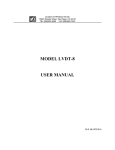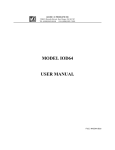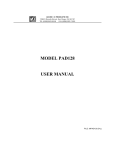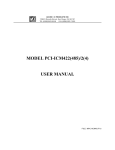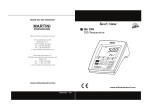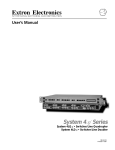Download MODEL PCI-COM422/8 USER MANUAL
Transcript
ACCES I/O PRODUCTS INC
10623 Roselle Street, San Diego, CA 92121
TEL (858)550-9559
FAX (858)550-7322
MODEL PCI-COM422/8
USER MANUAL
FILE: MPCICOM422-8.D1d
Notice
The information in this document is provided for reference only. ACCES does not assume any liability
arising out of the application or use of the information or products described herein. This document may
contain or reference information and products protected by copyrights or patents and does not convey any
license under the patent rights of ACCES, nor the rights of others.
IBM PC, PC/XT, and PC/AT are registered trademarks of the International Business Machines Corporation.
Printed in USA. Copyright 1995 by ACCES I/O Products Inc, 10623 Roselle Street, San Diego, CA 92121.
All rights reserved.
Page iii
Warranty
Prior to shipment, ACCES equipment is thoroughly inspected and tested to applicable specifications.
However, should equipment failure occur, ACCES assures its customers that prompt service and support
will be available. All equipment originally manufactured by ACCES which is found to be defective will be
repaired or replaced subject to the following considerations.
Terms and Conditions
If a unit is suspected of failure, contact ACCES' Customer Service department. Be prepared to give the unit
model number, serial number, and a description of the failure symptom(s). We may suggest some simple
tests to confirm the failure. We will assign a Return Material Authorization (RMA) number which must
appear on the outer label of the return package. All units/components should be properly packed for handling
and returned with freight prepaid to the ACCES designated Service Center, and will be returned to the
customer's/user's site freight prepaid and invoiced.
Coverage
First Three Years: Returned unit/part will be repaired and/or replaced at ACCES option with no charge for
labor or parts not excluded by warranty. Warranty commences with equipment shipment.
Following Years: Throughout your equipment's lifetime, ACCES stands ready to provide on-site or in-plant
service at reasonable rates similar to those of other manufacturers in the industry.
Equipment Not Manufactured by ACCES
Equipment provided but not manufactured by ACCES is warranted and will be repaired according to the
terms and conditions of the respective equipment manufacturer's warranty.
General
Under this Warranty, liability of ACCES is limited to replacing, repairing or issuing credit (at ACCES
discretion) for any products which are proved to be defective during the warranty period. In no case is
ACCES liable for consequential or special damage arriving from use or misuse of our product. The
customer is responsible for all charges caused by modifications or additions to ACCES equipment not
approved in writing by ACCES or, if in ACCES opinion the equipment has been subjected to abnormal use.
"Abnormal use" for purposes of this warranty is defined as any use to which the equipment is exposed other
than that use specified or intended as evidenced by purchase or sales representation. Other than the above,
no other warranty, expressed or implied, shall apply to any and all such equipment furnished or sold by
ACCES.
Page iv
Table of Contents
Chapter 1: Introduction . . . . . . . . . . . . . . . . . . . . . . . . . . . . . . . . . . . . . . . . . . . . . . 1-1
RS422 Balanced Mode Operation . . . . . . . . . . . . . . . . . . . . . . . . . . . . . . . . . . . . . . . . . .
COM Port Compatibility . . . . . . . . . . . . . . . . . . . . . . . . . . . . . . . . . . . . . . . . . . . . . . . . . .
Communication Mode . . . . . . . . . . . . . . . . . . . . . . . . . . . . . . . . . . . . . . . . . . . . . . . . . . .
Baud Rate Ranges . . . . . . . . . . . . . . . . . . . . . . . . . . . . . . . . . . . . . . . . . . . . . . . . . . . . .
Specifications . . . . . . . . . . . . . . . . . . . . . . . . . . . . . . . . . . . . . . . . . . . . . . . . . . . . . . . . .
1-1
1-1
1-1
1-2
1-3
Chapter 2: Installation . . . . . . . . . . . . . . . . . . . . . . . . . . . . . . . . . . . . . . . . . . . . . . 2-1
CD Installation . . . . . . . . . . . . . . . . . . . . . . . . . . . . . . . . . . . . . . . . . . . . . . . . . . . . . . . . .
3.5-Inch Diskette Installation . . . . . . . . . . . . . . . . . . . . . . . . . . . . . . . . . . . . . . . . . . . . . .
Directories Created on the Hard Disk . . . . . . . . . . . . . . . . . . . . . . . . . . . . . . . . . . . . . . .
Installing the Card . . . . . . . . . . . . . . . . . . . . . . . . . . . . . . . . . . . . . . . . . . . . . . . . . . . . . .
Windows NT 4.0 Installation Instructions for the PCI-COM422/8 . . . . . . . . . . . . . . . . . .
2-1
2-1
2-2
2-4
2-5
Chapter 3: Option Selection . . . . . . . . . . . . . . . . . . . . . . . . . . . . . . . . . . . . . . . . . . 3-1
Chapter 4: Address Selection . . . . . . . . . . . . . . . . . . . . . . . . . . . . . . . . . . . . . . . . . 4-1
Chapter 5: Programming . . . . . . . . . . . . . . . . . . . . . . . . . . . . . . . . . . . . . . . . . . . . . 5-1
Sample Programs . . . . . . . . . . . . . . . . . . . . . . . . . . . . . . . . . . . . . . . . . . . . . . . . . . . . . .
Windows Programming . . . . . . . . . . . . . . . . . . . . . . . . . . . . . . . . . . . . . . . . . . . . . . . . . .
Initialization . . . . . . . . . . . . . . . . . . . . . . . . . . . . . . . . . . . . . . . . . . . . . . . . . . . . . . . . . . .
Reception . . . . . . . . . . . . . . . . . . . . . . . . . . . . . . . . . . . . . . . . . . . . . . . . . . . . . . . . . . . .
Transmission . . . . . . . . . . . . . . . . . . . . . . . . . . . . . . . . . . . . . . . . . . . . . . . . . . . . . . . . . .
5-1
5-1
5-1
5-3
5-4
Chapter 6: Connector Pin Assignments . . . . . . . . . . . . . . . . . . . . . . . . . . . . . . . . 6-1
Input/Output Connections . . . . . . . . . . . . . . . . . . . . . . . . . . . . . . . . . . . . . . . . . . . . . . . . 6-1
Page v
List of Figures
Figure 1-1: PCI-COM422/8 Block Diagram . . . . . . . . . . . . . . . . . . . . . . . . . . . . . . . .
Figure 3-1: Simplified Termination Schematic . . . . . . . . . . . . . . . . . . . . . . . . . . . . . .
Figure 3-2: PCI-COM422/8 Option Selection Map . . . . . . . . . . . . . . . . . . . . . . . . . . .
Figure 3-3: Low-Profile PCI-COM485/8 Option Selection Map . . . . . . . . . . . . . . . . . .
Page 1-4
Page 3-1
Page 3-2
Page 3-3
List of Tables
Table 5-1: Baud Rate Divisor Values . . . . . . . . . . . . . . . . . . . . . . . . . . . . . . . . . . . . . Page 5-2
Table 6-1: Connection Pin Assignments . . . . . . . . . . . . . . . . . . . . . . . . . . . . . . . . . . Page 6-1
Table 6-2: Data Cable Wiring . . . . . . . . . . . . . . . . . . . . . . . . . . . . . . . . . . . . . . . . . . . Page 6-2
Page vi
Chapter 1: Introduction
The PCI-COM422/8 Serial Interface Card was designed for effective transmission in RS422
(EIS422) protocol. The card is 7.83 inches long and may be installed in PCI-bus slots of IBM PC
or compatible computers. The card features eight independent, asynchronous RS422 serial ports,
type 16550 buffered UARTs.
RS422 Balanced Mode Operation
The PCI-COM422/8 supports RS422 communications and uses differential balanced drivers for long
range and noise immunity. PCI-COM422/8 also has the capability to add load resistors to terminate
the communications lines. RS422 communications requires that a transmitter supply a bias voltage
to ensure a known "zero" state. Also, receiver inputs at each end of the network should be
terminated to eliminate "ringing". The PCI-COM422/8 supports biasing by default and supports
termination by jumpers on the card. If your application requires the transmitter to be un-biased,
please contact the factory.
COM Port Compatibility
Type 16550 UARTs are used as the Asynchronous Communication Element (ACE). These include
a 16-byte transmit/receive buffer to protect against lost data in multitasking operating systems, while
maintaining 100% compatibility with the original IBM serial port. The system assigns the
address(es).
A crystal oscillator is located on the card. This oscillator permits precise selection of baud rates up
to 115,200 or, by changing a jumper, up to 921,600 with the standard crystal oscillator.
The driver/receiver used, the SN75176B, is capable of driving extremely long communication lines
at high baud rates. It can drive up to ±60 mA on balanced lines and receive inputs as low as 200 mV
differential signal superimposed on common mode noise of +12 V or -7 V. In case of
communication conflict, the driver/receivers feature thermal shutdown.
Communication Mode
PCI-COM422/8 supports Full-Duplex and Half-Duplex communications with a 4-wire cable
connection. Half-Duplex allows traffic to travel in both directions, but only one way at a time.
Manual MPCICOM422-8.D1d
Page 1-1
PCI-COM422/8 Manual
Baud Rate Ranges
The card has capability for two baud rate range selections and can be selected through the setting
of the CLK X1/CLK X4 jumper. The baud rates are selected on a port-by-port basis. One range is
for up to 115,200 baud applications and the other is up to 921,600 baud applications. The lower
baud rate is selected when the jumper is in the CLK X1 position. When the jumper is in the X1
position we can utilize the industry standard baud rate selection methodology. When in the X4
position, we must compensate for the new input frequency by letting the Windows operating system
see the frequency at 1/4 of the selected value.
As an example when the X4 position is selected, assume the selected baud output is to be 9600 baud.
The operating system would need to have defined the value of 2400 baud so that the correct system
operations occur.
Note: Refer to the Baud Rate Divisor Value Table on page 5-1 of the manual.
Page 1-2
Manual MPCICOM422-8.D1d
Specifications
Communications Interface
•
•
•
•
•
•
•
•
•
•
I/O Connection:
Serial Ports:
50-pin SCSI D-Connector
Eight cable terminated shielded male D-sub 9-pin with standard
IBM AT Style connectors compatible with RS422 specifications.
Character length:
5, 6, 7, or 8 bits.
Parity:
Even, odd or none.
Stop Interval:
1, 1.5, or 2 bits.
Serial Data Rates:
Up to 115,200 baud, Asynchronous, A faster range of rates, up
to 921,600, is achieved by jumper selection on the card. Type
16550 buffered UART.
Address:
Continuously mappable within 0000 to FFFF (hex) range of PCI
bus addresses.
Receiver Input Sensitivity:
±200 mV, differential input.
Common Mode Rejection:
+12V to -7V
Transmitter Output Drive Capability: 60 mA, with thermal shutdown.
Environmental
•
•
•
Operating Temperature Range: 0 °C. to +60 °C.
Storage temperature Range:
-50 °C. to +120 °C.
Humidity:
5% to 95%, non-condensing.
•
Power Required:
•
Size:
+5VDC at 125 mA typical, -12VDC at 5 mA typical, +12VDC
at 5 mA typical, 750 mW total power consumption.
7.8 Inches long (198 mm) by 3.8 inches high (97 mm).
Manual MPCICOM422-8.D1d
Page 1-3
PCI-COM422/8 Manual
Figure 1-1: PCI-COM422/8 Block Diagram
(Only one serial channel shown)
Page 1-4
Manual MPCICOM422-8.D1d
Chapter 2: Installation
The software provided with this card is contained on either one CD or multiple diskettes and must
be installed onto your hard disk prior to use. To do this, perform the following steps as appropriate
for your software format and operating system. Substitute the appropriate drive letter for your
CD-ROM or disk drive where you see d: or a: respectively in the examples below.
CD Installation
DOS/WIN3.x
1.
2.
3.
4.
Place the CD into your CD-ROM drive.
Type d:K to change the active drive to the CD-ROM drive.
Type installK to run the install program.
Follow the on-screen prompts to install the software for this card.
WIN95/98/NT
1.
2.
3.
Place the CD into your CD-ROM drive.
The CD should automatically run the install program after 30 seconds. If the install program
does not run, click START | RUN and type d:install, click OK or press K.
Follow the on-screen prompts to install the software for this card.
3.5-Inch Diskette Installation
As with any software package, you should make backup copies for everyday use and store your
original master diskettes in a safe location. The easiest way to make a backup copy is to use the DOS
DISKCOPY utility.
In a single-drive system, the command is:
diskcopy a: a:K
You will need to swap disks as requested by the system.
In a two-disk system, the command is:
diskcopy a: b:K
This will copy the contents of the master disk in drive A to the backup disk in drive B.
Manual MPCICOM422-8.D1d
Page 2-1
PCI-COM422/8 Manual
To copy the files on the master diskette to your hard disk, perform the following steps.
1.
Place the master diskette into a floppy drive.
2.
Change the active drive to the drive that has the diskette installed. For example, if the
diskette is in drive A, type a:K.
3.
Type installK and follow the on-screen prompts.
Directories Created on the Hard Disk
The installation process will create several directories on your hard disk. If you accept the
installation defaults, the following structure will exist.
[CARDNAME]
Root or base directory containing the SETUP.EXE setup program used to help you configure
jumpers and calibrate the card.
DOS\PSAMPLES:
DOS\CSAMPLES:
Win32\language:
A subdirectory of [CARDNAME] that contains Pascal samples.
A subdirectory of [CARDNAME] that contains "C" samples.
Subdirectories containing samples for Win95/98 and NT.
WinRisc.exe
A Windows dumb-terminal type communication program designed for RS422/485 operation.
Used primarily with Remote Data Acquisition Pods and our RS422/485 serial communication
product line. Can be used to say hello to an installed modem.
ACCES32
This directory contains the Windows 95/98/NT driver used to provide access to the hardware
registers when writing 32-bit Windows software. Several samples are provided in a variety of
languages to demonstrate how to use this driver. The DLL provides four functions (InPortB,
OutPortB, InPort, and OutPort) to access the hardware.
This directory also contains the device driver for Windows NT, ACCESNT.SYS. This device driver
provides register-level hardware access in Windows NT. Two methods of using the driver are
available, through ACCES32.DLL (recommended) and through the DeviceIOControl handles
provided by ACCESNT.SYS (slightly faster).
Page 2-2
Manual MPCICOM422-8.D1d
SAMPLES
Samples for using ACCES32.DLL are provided in this directory. Using this DLL not only
makes the hardware programming easier (MUCH easier), but also one source file can be used
for both Windows 95/98 and WindowsNT. One executable can run under both operating
systems and still have full access to the hardware registers. The DLL is used exactly like any
other DLL, so it is compatible with any language capable of using 32-bit DLLs. Consult the
manuals provided with your language's compiler for information on using DLLs in your specific
environment.
VBACCES
This directory contains sixteen-bit DLL drivers for use with VisualBASIC 3.0 and Windows 3.1
only. These drivers provide four functions, similar to the ACCES32.DLL. However, this DLL is
only compatible with 16-bit executables. Migration from 16-bit to 32-bit is simplified because of
the similarity between VBACCES and ACCES32.
PCI
This directory contains PCI-bus specific programs and information. If you are not using a PCI card,
this directory will not be installed.
SOURCE
A utility program is provided with source code you can use to determine allocated resources at
run-time from your own programs in DOS.
PCIFind.exe
A utility for DOS and Windows to determine what base addresses and IRQs are allocated to
installed PCI cards. This program runs two versions, depending on the operating system. Windows
95/98/NT displays a GUI interface, and modifies the registry. When run from DOS or Windows3.x,
a text interface is used. For information about the format of the registry key, consult the
card-specific samples provided with the hardware. In Windows NT, NTioPCI.SYS runs each time
the computer is booted, thereby refreshing the registry as PCI hardware is added or removed. In
Windows 95/98/NT PCIFind.EXE places itself in the boot-sequence of the OS to refresh the registry
on each power-up.
This program also provides some COM configuration when used with PCI COM ports. Specifically,
it will configure compatible COM cards for IRQ sharing and multiple port issues.
WIN32IRQ
This directory provides a generic interface for IRQ handling in Windows 95/98/NT. Source code
is provided for the driver, greatly simplifying the creation of custom drivers for specific needs.
Samples are provided to demonstrate the use of the generic driver. Note that the use of IRQs in
near-real-time data acquisition programs requires multi-threaded application programming
techniques and must be considered an intermediate to advanced programming topic. Delphi, C++
Builder, and Visual C++ samples are provided.
Manual MPCICOM422-8.D1d
Page 2-3
PCI-COM422/8 Manual
Findbase.exe
DOS utility to determine an available base address for ISA bus , non-Plug-n-Play cards. Run this
program once, before the hardware is installed in the computer, to determine an available address
to give the card. Once the address has been determined, run the setup program provided with the
hardware to see instructions on setting the address switch and various option selections.
Poly.exe
A generic utility to convert a table of data into an nth order polynomial. Useful for calculating
linearization polynomial coefficients for thermocouples and other non-linear sensors.
Risc.bat
A batch file demonstrating the command line parameters of RISCTerm.exe.
RISCTerm.exe
A dumb-terminal type communication program designed for RS422/485 operation. Used primarily
with Remote Data Acquisition Pods and our RS422/485 serial communication product line. Can be
used to say hello to an installed modem. RISCTerm stands for Really Incredibly Simple
Communications TERMinal.
Installing the Card
The PCI-COM422/8 card can be installed in a five-volt PCI slot of an IBM or compatible computer.
Before , carefully read the Option Selection section of this manual and configure the card according
to your requirements. Finally, our SETUP.EXE program will lead you through the process of setting
the options on the PCI-COM422/8. The setup program does not set the options. These must be set
manually by jumpers on the card.
To Install the Card
1.
2.
3.
4.
5.
6.
Page 2-4
Turn OFF computer power.
Remove the computer cover.
Install jumpers from either the Option Selection section of this manual or the suggestions
of our SETUP.EXE software program.
Install the card in an available PCI-bus slot.
Replace the computer cover and turn the computer ON.
Enter the CMOS setup program of your system and verify that the PCI plug-and-play option
is set appropriately for your system. Systems running Windows95 (or any other
PNP-compliant Operating System) should set the CMOS option to OS. Systems running
under DOS, WindowsNT 3.51, Windows 3.1, or any other non-PNP-compliant Operating
System should set the PNP CMOS option to BIOS or Motherboard. Save the option and
continue booting the system.
Manual MPCICOM422-8.D1d
A "spider" cable is provided to interface between the 50-pin SCSI connector on the card, and your
system cabling. Eight individual 9-pin connectors are provided.
If you are using Windows95, your operating system should detect the new hardware and prompt you
for the installation disk. Insert the ACCES-provided diskette into the A drive and allow the
operating system to look for the files that it wants.
The base address assigned by BIOS or the operating system can change each time new hardware is
installed into or removed from the computer.
PCI cards are assigned resources by the system. To determine the resource assigned, run PCIFind
or look in the operating systems list of Detected Devices. In Win95/98/NT, this is the Device
Manager of the system applet, found in the control panel. See the Tools diskette for more
information on PCIFind.
Windows NT 4.0 Installation Instructions for the PCI-COM422/8
Unlike Windows95, NT4.0 is not a plug-and-play compliant Operating System. Windows NT will
not auto-detect and install new hardware devices. Therefore, in order to tell Windows NT that you
have installed eight new COM ports, you must use the utilities provided by NT in the Control Panel.
Once you have installed the card in the computer and the system is booted to Windows NT 4.0
(Service Pack 3 or higher is recommended), you will also need to install several drivers and utilities
provided. These utilities are designed to detect the location of the hardware and report the base
address and IRQ assignments for your use. The TOOLS diskette contains these programs.
Place the TOOLS disk in a floppy drive (ex: A:), click the Start Menu, select the Run menu item,
and type A:INSTALL [enter]. This will run the installation program from the floppy disk to install
the software to your hard-disk.
Once the software installation is complete, run PCIFind.EXE from the root directory created on the
hard disk. This program copies NTIOPCI.SYS to the [NT]\SYSTEM32\DRIVERS directory and
dynamically loads and runs the driver.
Note
If you previously installed an older version of NTIOPCI.SYS, please delete the file from your
[NT]\SYSTEM32\DRIVERS directory prior to running PCIFind.
Manual MPCICOM422-8.D1d
Page 2-5
PCI-COM422/8 Manual
PCIFind displays the list of COM addresses and the IRQ assigned and adds all pertinent registry
entries. The following steps are only necessary if there is a problem running PCIFind and the
registry is not updated.
Open the CONTROL PANEL (START|RUN|CONTROL, START|SETTINGS|CONTROL PANEL,
or MY COMPUTER|CONTROL PANEL) and execute the PORTS applet.
Click Add...; a dialog box titled "Advanced Settings for New Port" will appear. Select the COM port
number of an available COM port, type the Base I/O Port Address of COMA and the IRQ from the
PCIFind screen. Click OK.
You have now installed one port in NT. Continue Clicking Add... and selecting addresses for the
remainder of the eight ports.
All these steps are performed manually, but could be automated, by making registry entries in
various registry keys. Consult your Microsoft provided documentation for more information.
The base addresses and IRQ of the PCI-COM422/8 is provided in the registry under the NTIOPCI
key, in a structure of type PCI_COMMON_CONFIG. See the sample program for a demonstration
of how to read this structure and extract the addresses in an application program.
Interrupts
Please note that, in Windows NT, changes must be made to the system registry to support IRQ
sharing. The following is excerpted from "Controlling Multiport Serial I/O Cards" provided by
Microsoft in the MSDN library, documentid:mk:@ivt:nt40res/D15/S55FC.HTM, also available in
the WindowsNT Resource Kit.
The Microsoft serial driver can be used to control many dumb multiport serial cards. Dumb
indicates that the control includes no on-board processor. Each port of a multiport card has a
separate subkey under the HKLM\CurrentControlSet\Services\Serial\Parameters subkey in the
registry. In each of these subkeys, you must add values for DosDevices, Interrupt, InterruptStatus,
PortAddress, and PortIndex because these are not detected by the Hardware Recognizer. (For
descriptions and ranges for these values, see Regentry.hlp, the Registry help file on the WindowsNT
Workstation Resource Kit CD.)
Page 2-6
Manual MPCICOM422-8.D1d
For example, if you have an eight-port PCI-COM422/8 card configured to use address 0xFC00 with
an interrupt of 05, the values in the Registry are:
Serial##### Subkey:
PortAddress = REG_DWORD 0xFC00
Interrupt = REG_WORD 5
DosDevices = REG_SZ COM5
InterruptStatus = REG_DWORD 0xFC40
PortIndex = REG_DWORD 1
Serial##### Subkey:
PortAddress = REG_DWORD 0xFC20
Interrupt = REG_DWORD 5
DosDevices = REG_SZ COM9
InterruptStatus = REG_DWORD 0xFC40
PortIndex - REG_DWORD 5
Serial##### Subkey:
PortAddress = REG_DWORD 0xFC08
Interrupt = REG_DWORD 5
DosDevices = REG_SZ COM6
InterruptStatus = REG_DWORD 0xFC40
PortIndex = REG_DWORD 2
Serial##### Subkey:
PortAddress = REG_DWORD 0xFC28
Interrupt = REG_DWORD 5
DosDevices = REG_SZ COM10
InterruptStatus = REG_DWORD 0xFC40
PortIndex = REG_DWORD 6
Serial##### Subkey:
PortAddress =_DWORD 0xFC10
Interrupt = REG_DWORD 5
DosDevices = REG_SZ COM7
InterruptStatus = REG_DWORD 0xFC40
PortIndex - REG_DWORD 3
Serial##### Subkey:
PortAddress = REG_DWORD 0xFC30
Interrupt = REG_DWORD 5
DosDevices = REG_SZ COM11
InterruptStatus = REG_DWORD 0xFC40
PortIndex = REG_DWORD 7
Serial##### Subkey:
PortAddress = REG_DWORD 0xFC18
Interrupt = REG_DWORD 5
Dos Devices = REG_SZ COM8
InterruptStatus = REG_DWORD 0xFC40
PortIndex = REG_DWORD4
Serial##### Subkey:
PortAddress = REG_DWORD 0xFC38
Interrupt = REG_DWORD 5
DosDevices = REG_SZ COM12
InterruptStatus = REG_DWORD 0xFC40
PortIndex = REG_DWORD8
As this example shows, the shared IRQ status Register is located at Base address + 0x40.
Manual MPCICOM422-8.D1d
Page 2-7
PCI-COM422/8 Manual
Page 2-8
Manual MPCICOM422-8.D1d
Chapter 3: Option Selection
To help you locate the jumpers described in this section, refer to the Option Selection Map at the
end of this section. Operation of the serial communications section is determined by jumper
installation as described in the following paragraphs.
Terminations
A transmission line should be terminated at the receiving end in its characteristic impedance.
Installing a jumper at the locations labeled LDxO and LDxI apply a 120S load across the
transmit/receive input/output for RS422 operation.
In RS422 operations where there are multiple
terminals, only the RS422 ports at the receiver
end of the network should have terminating
impedance as described above. To so terminate
the COM A port, place a jumper at the location
labeled LDAO. To terminate the COM B, COM
C, COM D, COM E, COM F and COM H ports,
place jumpers at locations labeled LDBO,
LDCO, LDDO, LDEO, LDFO LDGO and
LDHO respectively. Similarly, Inputs are
terminated at jumpers labeled LDAI, LDB1, etc.
Figure 3-1: Simplified Termination Schematic
Also, for RS422 operation, there must be a bias on the RX+ and RX- lines. If the COM422/8 card
is not to provide that bias, contact the factory technical support.
Data Cable Wiring
Signal
Pin Connection
AinAout+
Aout100 S to Ground
Ain+
1
2
3
5
9
Baud Rate Ranges
The jumpers labeled CLK X1 and CLK X4 provide means to select baud rates in either of two
ranges. When in the "X1" position, the baud rate range is up to 115,200 baud. When in the CLK
X4 position, the baud rate range is 200 to 921,600 baud.
Manual MPCICOM422-8.D1d
Page 3-1
PCI-COM422/8 Manual
Figure 3-2: PCI-COM422/8 Option Selection Map
Page 3-2
Manual MPCICOM422-8.D1d
Figure 3-3: Low-Profile PCI-COM485/8 Option Selection Map
Manual MPCICOM422-8.D1d
Page 3-3
Chapter 4: Address Selection
The PCI-COM422/8 card uses one address space. COM A, COM B, COM C, COM D, COM E,
COM F, COM G, and COM H each occupy eight consecutive register locations. The interrupt
register which indicates which port or ports caused the interrupt is located at base address + 64.
PCI architecture is Plug-and-Play. This means that the BIOS or Operating System determines the
resources assigned to PCI cards rather than you selecting those resources with switches or jumpers.
As a result, you cannot set or change the card's base address. You can only determine what the
system has assigned.
To determine the base address that has been assigned, run the PCIFind.EXE, or PCINT utility
program provided. This utility will display a list of all of the ACCES cards detected on the PCI bus,
the addresses assigned to each function on each of the cards, and the respective IRQs (if any)
allotted.
Alternatively, some operating systems (Windows95/98/2000) can be queried to determine which
resources were assigned. In these operating systems, you can use either PCIFind (DOS) or PCINT
(Windows95/98/NT), or the Device Manager utility from the System Applet of the control panel.
The PCI-COM422/8 is installed in the Data Acquisition class of the Device Manager list. Selecting
the card, clicking Properties, and then selecting the Resources Tab will display a list of the resources
allocated to the card.
The PCI bus supports 64K of I/O space, so your card's addresses may be located anywhere in the
0000 to FFFF hex range.
Vendor ID code is 494F (ASCII for "I/O")
Device ID code is 1068
Manual MPCICOM422-8.D1d
Page 4-1
Chapter 5: Programming
Sample Programs
There are sample programs provided with the PCI-COM422/8 card in C, Pascal, QuickBASIC, and
several Windows languages. DOS samples are located in the DOS directory and Windows samples
are located in the WIN32 directory.
Windows Programming
The PCI-COM422/8 card installs into Windows as COM ports. Thus the Windows standard API
functions can be used. In particular:
<
<
CreateFile() and CloseHandle() for opening and closing a port.
SetupComm(), SetCommTimeouts(), GetCommState(), and SetCommState() to set and change
a port’s settings.
< ReadFile() and WriteFile() for accessing a port.
See the documentation for your chosen language for details.
Under DOS, the process is very different. The remainder of this chapter describes DOS
programming.
Initialization
Initializing the chip requires knowledge of the UART's register set. The first step is to set the baud
rate divisor. You do this by first setting the DLAB (Divisor Latch Access Bit) high. This bit is Bit
7 at Base Address +3. In C code, the call would be:
outportb(BASEADDR +3,0x80);
You then load the divisor into Base Address +0 (low byte) and Base Address +1 (high byte). The
following equation defines the relationship between baud rate and divisor:
desired baud rate = (UART clock frequency) / (32 * divisor)
On the PCI-COM422/8 card, the UART clock frequency is 1.8432 MHz. On the next page is a table
for the popular divisor frequencies.
Manual MPCICOM422-8.D1d
Page 5-1
PCI-COM422/8 Manual
Bau d Rate
Divisor
x1
Divisor
x8
M ax Diff. Cable Length *
921600
N/A
1
250 ft
460800
N/A
2
500 ft
230400
N/A
4
800 ft
153600
N/A
6
130 0 ft
115200
1
8
220 0 ft
57600
2
16
400 0 ft
38400
3
24
400 0 ft
28800
4
32
400 0 ft
19200
6
48
400 0 ft
14400
8
64
400 0 ft
9600
12
96
400 0 ft
4800
24
192
400 0 ft
2400
48
384
400 0 ft
1200
96
768
400 0 ft
*These are theoretical maximums based on typical conditions and good quality cables based on the
EIA 485 and EIA 422 standard for balanced differential drivers. RS232 communication lines have
a maximum length of 50 feet, regardless of speed.
Table 5-1: Baud Rate Divisor Values
In C, the code to set the chip to 9600 baud is:
outportb(BASEADDR, 0x0C);
outportb(BASEADDR +1,0);
Page 5-2
Manual MPCICOM422-8.D1d
The second initializing step is to set the Line Control Register at Base Address +3. This register
defines word length, stop bits, parity, and the DLAB.
Bits 0 and 1 control word length and allow word lengths from 5 to 8 bits. Bit settings are
extracted by subtracting 5 from the desired word length.
Bit 2 determines the number of stop bits. There can be either one or two stop bits. If Bit 2 is
set to 0, there will be one stop bit. If Bit 2 is set to 1, there will be two stop bits.
Bits 3 through 6 control parity and break enable.
communications and should be set to zeroes.
They are not commonly used for
Bit 7 is the DLAB discussed earlier. It must be set to zero after the divisor is loaded or else
there will be no communications.
The C command to set the UART for an 8-bit word, no parity, and one stop bit is:
outportb(BASEADDR +3, 0x03)
Reception
Reception can be handled in two ways: polling and interrupt-driven. When polling, reception is
accomplished by constantly reading the Line Status Register at Base Address +5. Bit 0 of this
register is set high whenever data are ready to be read from the chip. A simple polling loop must
continuously check this bit and read in data as it becomes available. The following code fragment
implements a polling loop and uses a value of 13, (ASCII Carriage Return) as an end-of-transmission
marker:
do
{
while (!(inportb(BASEADDR +5) & 1)); /*Wait until data ready*/
data[i++]= inportb(BASEADDR);
}
while (data[i]!=13); /*Reads the line until null character rec'd*/
Interrupt-driven communications should be used whenever possible and is required for high data
rates. Writing an interrupt-driven receiver is not much more complex than writing a polled receiver
but care should be taken when installing or removing your interrupt handler to avoid writing the
wrong interrupt, disabling the wrong interrupt, or turning interrupts off for too long a period.
Manual MPCICOM422-8.D1d
Page 5-3
PCI-COM422/8 Manual
The handler would first read the Interrupt Identification Register at Base Address +2. If the interrupt
is for Received Data Available, the handler then reads the data. If no interrupt is pending, control
exits the routine. A sample handler, written in C, is as follows:
readback = inportb(BASEADDR +2);
if (readback & 4)
/*Readback will be set to 4 if data are available*/
data[i++]=inportb(BASEADDR);
outportb(0x20,0x20);
/*Write EOI to 8259 Interrupt Controller*/
return;
Transmission
To transmit a string of data, the transmitter must first check Bit 5 of the Line Status Register at Base
Address +5. That bit is the transmitter-holding-register-empty flag. If it is high, the transmitter has
sent the data. The process of checking the bit until it goes high followed by a write is repeated until
no data remains.
The following C code fragment demonstrates this process:
while(data[i]); /*While there is data to send*/
{
while(!(inportb(BASEADDR +5)&0x20)); /*Wait until transmitter is empty*/
outportb(BASEADDR,data[i]);
i++;
}
Page 5-4
Manual MPCICOM422-8.D1d
Chapter 6: Connector Pin Assignments
Input/Output Connections
The PCI-COM422/8 Serial Communications card uses a 50-pin SCSI D-connector to interface to a
spider cable. The spider cable has eight individual 9-pin connectors provided with it.
To ensure that there is minimum susceptibility to EMI and minimum radiation it is important that
the card mounting bracket be properly screwed into place and that there be a positive chassis ground.
Also, proper EMI cabling techniques (cable connect to chassis ground at the aperture, shielded
twisted-pair wiring, etc) must be used for the input/output wiring.
Pin Number
RS-4 22 S igna ls
Pin 1
GN D
Pin 2
Pin 3
Ground
Pin Number
RS-4 22 S igna ls
Pin 26
GN D
Aout+
Pin 27
Eout+
Aout-
Pin 28
Eout-
Pin 4
Ground through 100 Ohm R
Pin 29
Ground through 100 Ohm R
Pin 5
Ain+
Pin 30
Ein+
Pin 6
Ain-
Pin 31
Ein-
Pin 7
GN D
Pin 32
GN D
Pin 8
Bo ut+
Pin 33
Fout+
Pin 9
Bo ut-
Pin 34
Fout-
Pin 10
Ground through 100 Ohm R
Pin 35
Ground through 100 Ohm R
Pin 11
Bin+
Pin 36
Fin+
Pin 12
Bo ut-
Pin 37
Fout-
Pin 13
GN D
Pin 38
GN D
Pin 14
Cout+
Pin 39
Go ut+
Pin 15
Cout-
Pin 40
Go ut-
Pin 16
Ground through 100 Ohm R
Pin 41
Ground through 100 Ohm R
Pin 17
Cin+
Pin 42
Gin+
Pin 18
Cin-
Pin 43
Gin-
Pin 19
GN D
Pin 44
GN D
Pin 20
Do ut+
Pin 45
Ho ut+
Pin 21
Do ut-
Pin 46
Ho ut-
Pin 22
Ground through 100 Ohm R
Pin 47
Ground through 100 Ohm R
Pin 23
Din+
Pin 48
Hin+
Pin 24
Din-
Pin 49
Hin-
Pin 25
GN D
Pin 50
GN D
Ground
Ground
Ground
Ground
Ground
Ground
Ground
Ground
Ground
Table 6-1: Connection Pin Assignments
Manual MPCICOM422-8.D1d
Page 6-1
PCI-COM422/8 Manual
Signal
Co nnector Pin
Ain-
Pin 1
Aout+
Pin 2
Aout-
Pin 3
100 O hm to Ground
Pin 5
Ain+
Pin 9
Table 6-2: Data Cable Wiring
Page 6-2
Manual MPCICOM422-8.D1d
Customer Comments
If you experience any problems with this manual or just want to give us some feedback, please email
us at: [email protected].. Please detail any errors you find and include your mailing
address so that we can send you any manual updates.
10623 Roselle Street, San Diego CA 92121
Tel. (619)550-9559 FAX (619)550-7322
www.accesioproducts.com





























